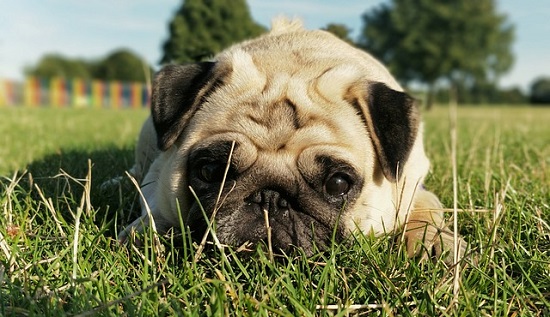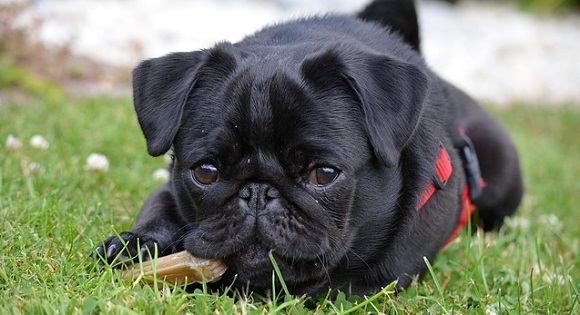What is Possession Aggression?
Does your sudden appearance in the kitchen at doggy mealtime elicit a glare and a growl? Does a gift of a rawhide bone send your usually mild-mannered canine diving under the nearest coffee table while snarling, "Grrr, mine?" If so, your dog is suffering from Canine Possession Aggression (CPA), which is also known as food or object guarding.
In most cases of CPA, the dog no longer views you as the provider of good things, but rather as the scoundrel who relieves him of hard-earned treasures such as meals, treats, and chew toys or in some instances, forbidden objects such as shoes and gloves. To take away these items as punishment when he growls will only serve to convince him that his suspicions about you were right.
How often have you heard people say, "Leave the dog alone while he eats?" While it probably makes sense to keep toddlers looking for horsey back rides away from Shep at mealtime, a dog can get an inflated sense of himself if he is used to being left alone while he eats. He begins to believe that he is Lord Master of the Kitchen. After all, in a dog or wolf pack, the alpha or top dog would get to eat his fill first. Starting in puppy hood, family members should be present while the dog eats. From time to time, it is wise to approach the bowl and add a little something extra such as scrambled eggs, a broken-up biscuit, a piece of a turkey hotdog or some string cheese.
Helping an older dog with food aggression
If you have an older dog that has already perfected his mealtime Cujo imitation, a different approach must be taken:
- Do away with his food bowl for a week or two. Shep will be dining out of your hand, a few kibbles at a time.
- Bring back the food bowl. It should remain empty until you pass by and drop a few pieces of kibble in it. After those are eaten up, you should drop small handfuls of kibble in at two-minute intervals until the entire meal has been eaten. By now your dog should be practically begging you to approach his bowl.
- Put a semi-filled bowl on the floor and as you pass by, drop in a few better-than kibble tidbits. Then add the remaining kibble in your next pass.
- Put a full food bowl on the floor as your dog holds a sit-stay. Release him with a cheery "okay." Then once or twice a week, call your dog away from his bowl and reward him for coming over to you with a tasty tidbit. Please use your "sit-stay," "wait," and "take it" commands with the dog so it is absolutely clear to Shep who owns the kitchen and the tasty morsels in it.
Each of these steps should be undertaken for 10 to 14 days for both breakfast and dinner. While you are grappling with a food-guarding problem, your dog should wear a leash at mealtimes as a safety measure. Don't use it to correct him unless you are in jeopardy of being hurt. Since food guarding seldom happens in a vacuum and often signals other problems in the dog/owner relationship, a basic obedience course is highly recommended for canines who exhibit this behavior. Finally, if you experience any backsliding, return to Step One. Slow and steady wins this contest of wills.
Food Aggression: One Adopter's method used with her Rescued Dog
Scooter is winding up week 3 on food retraining, and I am confident now that a behaviorist will not be necessary. With the help of the articles, and some of my own research, I instigated the "three step plan". What a difference it has made for Scooter!
During Step 1, as in the article, Dan and I fed Scooter only out of our hands for one full week. Already after the week was over, Scooter was looking far more humble and much more appreciative
During Step 2, Week 2, Scooter did get his bowl back. He was fed only a handful of kibble at a time. While he was finishing that up, I would put another handful of kibble in the bowl. For that entire week, he was fed kibble by the handful in his bowl, but I was around him all the time while he was eating, putting in more food, lifting up his bowl, patting him on the head, putting my hand in his bowl with more food, moving his bowl around, putting more food in it, etc.
This week is hot dog week. Scooter starts his meal on his sit stay with his dog food bowl half filled. While he is eating that, I cut up hot dogs. The first day I put Scooter on his lead while he ate, and in the middle of his meal I told him to leave it. (Not an easy task for Scooter). I then told him to come to me, and I pulled him along with the lead. When he arrived (lots of praise) and a couple of pieces of hot dog for coming! By day 2 and 3, all I had to do was to say to Scooter LEAVE IT and COME and he stops eating and comes over to me, and gets big praise and good treats. During the second part of hot dog week, after he returns to the other half of his meal, I have been approaching his dish and dropping in a couple of pieces of hot dog. He now stops eating when I approach his bowl and waits for me. Most of the time he gets a tasty treat, sometimes I give him a good pat and tell him what a good dog he is, sometimes I lift up his bowl, and put a few more pieces of kibble in it. Last evening, I forgot to have him sit, so he did his own stand-stay, and waited for me to give him the o.k. to eat.
Needles to say, in less than three short weeks, there has been not one instance of snapping or gabbing. I notice that Scooter's eating habits are changing somewhat also. He doesn't seem to me as much to be "diving into his bowl and inhaling his food" like he used to. I think also now that during the added time it takes to feed him that he has a chance to let his body "fill up" more, and he doesn't have that hungry feeling by the time he is done eating.
I think after this week is through, that it will be sufficient to approach his bowl a few times during the week, with better than dog food stuff, just so he remembers that when we are near his bowl good things are bound to happen.
Object Guarding
While out walking Bosco, you scan the sidewalks and streets. As you pass the neighborhood butcher shop, the counter man offers you some beef marrow bones, but you politely decline. You are almost home free when a tennis ball bounces across your path. In one fell swoop, Bosco seizes it in his mighty jaws and growls "Mine!"
Food guarding was covered earlier. In this part, we discuss the second arm of Canine Possession Aggression - object guarding, which is the act of aggressively protecting toys, chewables such as rawhide bones, or stolen objects such as shoes, underwear and human food.
Why does the dog see the need to protect an item from his beloved family members? Because he thinks they are going to take it away. They've done it before, haven't they? As a puppy, Bosco roamed the house investigating his environment by picking up almost everything he could with his mouth. Every time he found a treasure, it was snatched away. Before long, Bosco upped the ante by growling, snarling and/or biting. What else is a dog to do?
Your dog should be used to having his mouth touched so that when you wish to remove something from it, you won't get bitten. From puppyhood on, brush your dog's teeth, play with his flews, open his mouth and inquire, "Anybody in there?" In other words, make it a game.
Purchase foot-long retriever sticks for dogs that have problems with rawhide and other bones. Hold on to one end of the stick while the dog chews on the other. Bosco may not enjoy this as much as hiding under a table with the stick, but in time he will get used to your presence and relax.
It is important for a dog to view his owner as the provider of all good things. This can be accomplished by tightly controlling the dog's environment. Keep all but a couple of chew toys up off the floor and take the others down only when you want to play. Make sure you offer an item with a command like "Take it." When you are tired of the game (you that is, not the dog), tell the dog to "Drop it." Give him another item in exchange, and then pick up the first object and put it away.
Do you know your dog's likes and dislikes? Compose a hierarchy of all the things your dog really enjoys including food, toys, treats and activities. In exchange for dropping the first item, give your dog a second, "better" item. For instance, if tennis ball retrieving is third on your dog's list, reward him with liver for dropping the tennis ball. If your canine tries to indulge in a choice bit of garbage from the street, command him to "drop it" and then throw him his tennis ball.
Someone higher up on the pack order ladder should be able to take whatever he wants from those further down the ladder. The family dog should be on the bottom rung, and any family member should be able to take anything from him. In reality, however, dominant dogs have a hard time believing children are above them on the ladder. In many households, the dog believes that his rightful place is on the rung between dad and mom, if not higher. If this is the case in your home, enroll your dog in a 30-day "tough love" leadership program to reclaim your rightful role as leader of the pack. Contact ASPCA Companion Animal Services for more information about this. If your dog's possession aggression problems have been years in the making or are to the point of making you fearful, it is imperative that you work with a professional dog trainer or behavior consultant. He or she will carefully access the situation and design a protocol that is tailor made for your dog and you.
ASPCA Companion Animal Services 424 East 92nd Street, New York, NY 10128-6804 (212) 876-7700, ext. 4421



